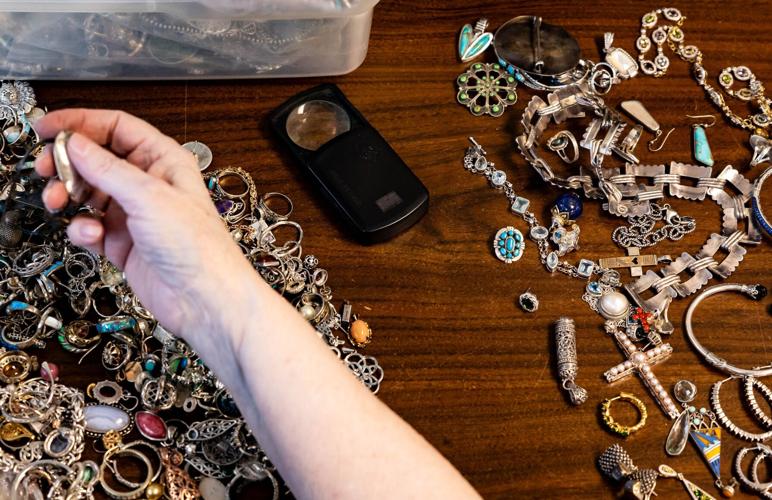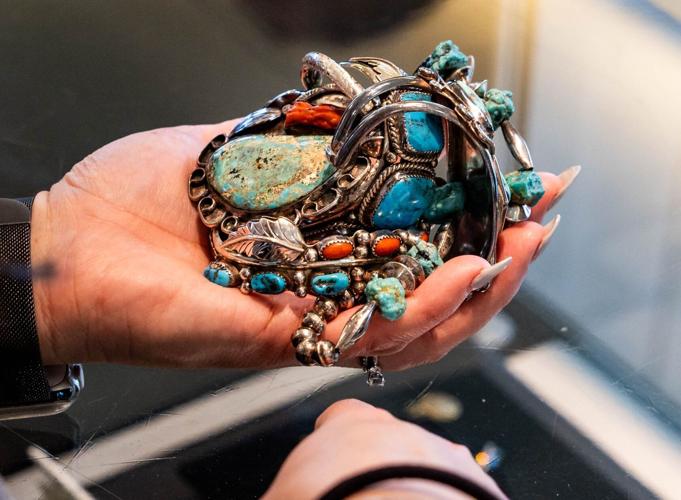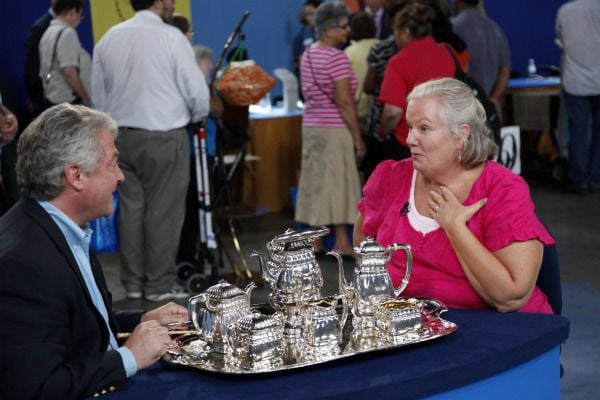CREVE COEUR тАФ Leann Adams, 63, carried old coin books, a fist-sized bag of loose change, a ring missing the center stone and two silver serving dishes into an appraisal shop lined with customers along every foot of the display counter.
Adams, of Ellisville, nearly turned back when she saw the full parking lot at Scotsman Coin and Jewelry on Olive Boulevard. But her husband had ventured in a few weeks ago with an old gold tooth that had been sitting in a drawer and walked out with $240.
She has been helping her parents downsize their home and clearing out piles of their stuff. She figured it may be worth finding out if any of their collectibles or household items had any value.
Adams waited in line and walked up to the next available spot. She laid her items in front of Cas Koziatek, who started working at the store when he was 13. His grandfather had owned the store. Koziatek quickly assessed the coin folders and determined most were simply worth the face value of the coins. The bag of exotic coins turned out to be assorted foreign currency, which didnтАЩt have resale value at the shop.
People are also reading…
Adams handed him the incomplete ring, from which she had removed the stone to have it reset. That brought an offer of $125 because of the high price of gold.

Robin Yeo of St. Peters, who sells antiques online, looks through silver jewelry at Scotsman Coin and Jewelry, removing items she wants to buy and resell, at the store in Creve Coeur on Thursday, March 20, 2025.
The clerk working next to Koziatek leaned over to confer about a rare coin a customer had shown him. Koziatek confirmed its value: That single coin was worth about $1,150.
Adams marveled at the nearby customerтАЩs good fortune. She gave Koziatek the two silver platters. He turned them over to look for a stamp marking the silver content. It turned out the trays were made of copper and silver-plated. He could offer about $50.
Adams said she came to the store without any expectations of how much her parentsтАЩ stuff might be worth. She decided to part with the ring and platters and with a plan to come back with a few more items that might fetch some cash.
тАЬIt was super easy and fast,тАЭ Adams says.
Selling and buying locally
The idea of finding hidden treasure in a junk drawer, attic or basement has long lured people to auction houses and appraisers.

An appraiser for "Antiques Roadshow" gives a woman good news about a silver tea set.┬а
Getting to watch strangers try their luck turned PBSтАЩs тАЬAntiques RoadshowтАЭ into the networkтАЩs most-watched ongoing series. The show will include ╙г╠╥╩╙╞╡ as part of its Season 30 five-city tour with a visit planned on May 13. A limited number of people will be chosen through a sweepstakes to receive free tickets. At each appraisal event, guests can bring two items and receive free verbal evaluations of their antiques, art and collectibles by experts from the countryтАЩs leading auction houses and independent dealers.
Those who donтАЩt score tickets to the PBS show or would prefer a more private evaluation can visit a number of local experts who can appraise and either auction, consign or buy valuable items.
Terry Beye, principal auctioneer and director of consignments at Selkirk Auctioneers and Appraisers, says visitors can make an appointment for a free appraisal the last Tuesday of every month at their downtown location at 555 Washington Avenue. They do not buy outright, but offer to sell through consignment or auction.
Beye recalls the times this has worked out to his clientsтАЩ great advantage.
About four years ago someone called him with an estate item out in the middle of rural Illinois. They wanted to get rid of a painting priced at $13,000, the caller said.

Jewelry specialist Nikki Hendricks examines a collection of jewelry brought in by a customer at Scotsman Coin and Jewelry in Creve Coeur.
Beye sent a colleague out to evaluate the art. It turned out to be an original work by Modernist painter Marsden Hartley.
At the Selkirk auction, a collector purchased it for more than half a million dollars.
Another time, he received a call from a man in Chesterfield wanting to sell him тАЬgold FrenchтАЭ tables тАФ $8,000 for the pair. He needed the money. Beye went to his apartment and recognized the English Satinwood tables from the late 18th century.
He convinced the man to put them up for auction. They sold for $540,000.
тАЬThatтАЩs a career highlight,тАЭ Beye says.
More often than not, he has to break harder news to a potential seller. They might have found a similar item to theirs through a Google search or listed on eBay for an artificially high price.
тАЬI like to use hard facts,тАЭ Beye says. He subscribes to a dozen or more appraisal-related websites and can pull up the prices that collectibles have actually sold for. In addition to the research, 40 years of experience have helped him hone his sense of how much a given item may bring at auction. He will look at paintings, furniture, Persian rugs, sculptures and other artwork.
The pandemic changed the way the bulk of their business operates.
тАЬIt taught people to bid from home,тАЭ he says.
Prior to COVID shutdowns, about 35 percent of bids came through online auctions. Now, 85 percent of items sell in online auctions.
Getting rid of an entire estate
Maria Lambert was working in the IT field and would shop to relieve stress. About 14 years ago, she spotted a unique item at an estate sale and wondered if she could resell it for a profit on eBay.
тАЬA monster was born,тАЭ she says. After working on the side for many years, she turned her passion into a full-time business in January 2017, ╙г╠╥╩╙╞╡ Estate Buyers, a full-service estate liquidation company that specializes in estate buyouts.
It has a retail location at West County Mall and recently opened a 15,000 square foot store in South County at 2151 Lemay Ferry Road.
On the last weekend of every month (Thursday through Saturday), people can walk into the West County store from 11 a.m. to 4 p.m. for jewelry appraisals. Lambert says the most fun conversations involve people who believe they are bringing in costume jewelry.
Recently, a woman brought in a jewelry box and described it as her momтАЩs тАЬjunk.тАЭ
Lambert offered her $2,200 for the pieces.
тАЬOh my God, IтАЩve been letting my grandkids play with her jewelry box,тАЭ the woman said. тАЬI wonder how much stuff theyтАЩve lost.тАЭ
Lambert says thereтАЩs missed value in jewelry, especially gold and silver because those rates per ounce are so high. She lets sellers know that they will typically offer a third to half of what the resale value of a piece of jewelry is.
тАЬWe will tell them upfront,тАЭ she says. тАЬWe will tell them how they can sell their own things and make more money.тАЭ
But plenty of people donтАЩt want to deal with hassle or wait for how long it might take an unusual or valuable piece to sell.
Lambert says she has discovered some unique pieces when they do an estate buyout. They have bought antique guns, military collectibles and even an Egyptian falcon mummy.
It can take anywhere from four to eight weeks for LambertтАЩs company to complete an online auction. Some sellers are willing to accept a lower price for a quicker payout. For those clients, they will offer a price on the entire estate and remove all the remaining items, as well.
She notes that there have been some big changes in the antiques market. Things that used to be valuable тАФ vases, china and crystal тАФ have significantly fallen in value. A seller will bring a set and say, тАЬThis was my grandmotherтАЩs, but my kids donтАЩt want it.тАЭ
She will tell them: тАЬNo oneтАЩs kids want it. ThatтАЩs the problem.тАЭ
They rarely auction an entire set of china. Boomers are downsizing, and some are getting pennies on the dollar for things they have collected, she says. But other pieces have become hot: Midcentury modern furniture and accessories, like turquoise blue china, and pieces with interesting lines. Items from the тАШ50s, тАШ60s and even тАШ70s are popular with younger buyers, she says.
She advises people to search eBay and look at the тАЬsoldтАЭ listings. In the local market, you can expect to get about a third of eBayтАЩs sold price if you sell to an auction house or retail reseller, she says.
Looking for a trustworthy buyer
Robert Koziatek, manager at Scotsman, said his grandfather started a coin company in 1955, which was in the family until 1971. His uncle has owned Scotsman since 1982. Their primary focus is on coins, paper money, watches, flatware, jewelry, diamonds and precious metals.
He said he aims to be as fair, honest and transparent with people as possible. Sometimes that means explaining how high the retail markup is at most fine jewelry retail stores тАФ anywhere from 100 to 400 percent above the actual value. While verbal appraisals are free, a written appraisal costs $30 per item, he says.
Sometimes, a person will find something that looks very different, such as a 1943 steel penny, which was made of zinc to save copper for the war effort. They may not know that the Mint made 1.5 billion of those pennies. Unless the penny is very rare the typical value is between 7 to 20 cents, Koziatek says.
The internet can be misleading if a seller only looks at the list price versus how much an item is actually sold for. Also, there may be differences in quality, condition, luster and rarity that may be vastly different and not as apparent from a listing online.
For most people, putting an item into an auction is the best bet to maximize how much money it may bring, Koziatek says. The store holds two large auctions open to the public annually тАФ in mid-to-late July and another in early November тАФ at the St. Charles Convention Center.
While appraisers and dealers consult Greysheets and subscription services that track prices for coins, they also rely on how items move in the marketplace.
тАЬYou know how fairly priced you are based on how quickly you can sell something,тАЭ Koziatek says. He said some potential sellers become upset when the store does not want to purchase an item. He suggests that they shop the item around to other reputable buyers in the area.
тАЬIf we could make money on it, we would be trying to buy it,тАЭ he says.
Andy Holman, co-owner of The Bricoluer antique store, talks about running his film camera store, STL Vintage Camera on Friday, April 7, 2023.












